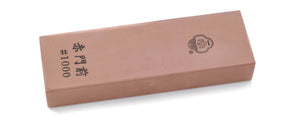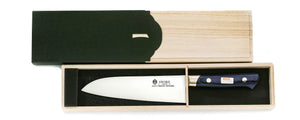Yanagiba Sashimi Knives

One of the three main traditional Japanese kitchen knives, yanagiba knives are designed to make sashimi slicing a dream, keeping food full of nutrients and flavor! Hand forged in Sakai, Osaka for hundreds of years, Sakai Ichimonji Mitsuhide is at the forefront, shipping right and left-handed knives globally.
What is a Japanese Yanagiba Knife (Sashimi Knife)?
A traditional Japanese Yanagiba is also called a “sashimi knife” or “sushi knife”. It’s used to slice through large slabs of salmon, tuna, and other raw fish to make sashimi, a mainstay of Japanese cuisine.
Unlike Western-style chef's knives, yanagiba knives are long, thin, and sharpened on only one side. This is usually the right-hand side, but left-handed versions are also available. The yanagiba's unique design evolved from the need to slice through fish without damaging any delicate muscle fibers and thereby ruining the flavor and mouthfeel.
The yanagiba's name originated from the shape of the knife being like a willow leaf (Yanagiba) or iris leaf (Shobu). The Yanagiba is one of the most common Japanese Knives in restaurants across Japan. If a restaurant sells sushi, you'll likely see one of these!
How to Choose a Yanagiba
To encourage long, clean cuts, we recommend a 270mm to 300mm blade length Yanagiba for most professional chefs.
For home cooks, we suggest 210mm to 240mm as any kitchen knife above that length is quite awkward in a home kitchen.
Carbon Steel or Stainless Steel?
Carbon Steel is easy to sharpen, holds the best edge and cuts with ease. This steel is susceptible to rust though, so it requires more maintenance and care.
Stainless Steel is rust resistant and easier to maintain, but cannot match Carbon Steel's sharpness despite recent improvements. Stainless Steel Knives are also more difficult to sharpen than Carbon Steel, requiring more patience.
Our Recommended Yanagiba Knives
White Steel #2 Tan Kasumi Yanagiba
Japanese White Steel #2 (Shirogami 2) is the most popular High Carbon Steel among Japanese chefs today. The Sakai Ichimonji White Steel #2 Tan Kasumi Yanagiba is made by forging a billet of White Steel #2 at low temperatures, keeping the steel's grain structure fine and uniform so that the final blade has a high edge retention and gives crisp slicing.
Please remember that White Steel #2 (Shirogami 2) is a High Carbon Steel and requires careful maintenance to prevent rust.
White Steel #1 Montanren Yanagiba
White Steel #1 (Shirogami 1) is the closest Japanese Knife steel to traditional Japanese Tamahagane Steel, which was historically used for Japanese swords (nihontou).
The Ichimonji White Steel #1 Montanren Yanagiba is forged by our expert craftsmen in Sakai. The forging process is difficult and requires a lot of skill on behalf of the craftsman to make a quality blade, but the result is a high-quality, very hard, sharp blade for slicing easily through blocks of meat in Japanese cuisine.
White Steel #1 (Shirogami 1) is also a High Carbon Steel and requires careful maintenance to prevent rust.
Silver Steel #3 Kasumi Yanagiba
Silver Steel #3 (Ginsan) is a traditional stainless steel that has been extensively used in the Japanese culinary world and has gained a reputation as a high-performance steel that is low maintenance and ideal for all kinds of kitchen knives and Japanese cutlery.
Hakugin Silver Steel #3 Kasumi Yanagiba with Saya
This "Hakugin Series" is a high-end model made by skilled craftsmen who have completed all the processes from quenching to sharpening and attaching handles.
If you are looking for a stainless-steel knife that is sharp and resistant to rust, this is the one for you.
Various types of sashimi knife
Other than Yanagiba, there are many types of knives that are similar and used in the same way as Yanagiba such as Takobiki and Fugibiki knives. You can also find unique tipped yanagiba knives, such as Kiritsuke-Yanagiba knives. There are some slight differences in shape, size, and weight. Chefs choose based on their personal preference.

How to Choose a Japanese Kitchen Knife for Beginners
Japanese kitchen knives are famous for their design, history, and cutting performance. This guide will help you select the best knife for your needs.































